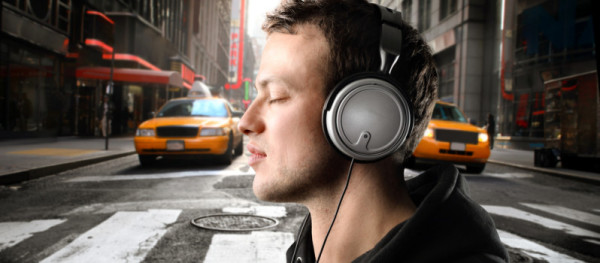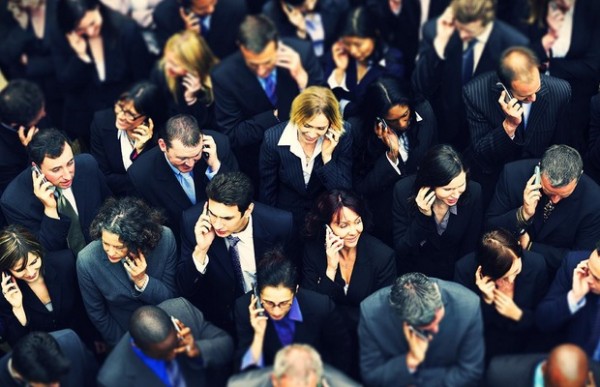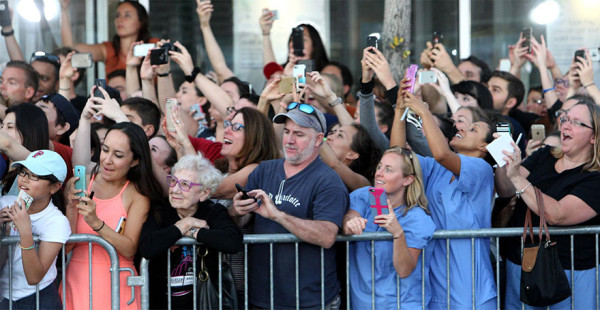One Way to Live in the Moment: Say Goodbye to Headphones

Source: Best Match
This past June, I decided to no longer wear headphones in public spaces. In public spaces, including the park, the grocery store, the post office, and on the bus to work, you won’t find me wearing headphones.
So, why not?

Source: MTA
Public transit, alone together
Four years ago, I accepted an internship at a non-profit in NYC. I moved to Brooklyn, so I had a decent commute to and from work, which was located in the Theater District of Manhattan. I spent much of my day on the L train, where I picked up a bad habit: wearing headphones the moment I left my apartment until I the minute I marched into work on 42nd Street.
Sometimes I wasn’t really listening to music. I would use my headphones as a “do not disturb” sign to others, to ward off unwanted conversation with strangers and attention from cat-callers. I’d bury myself in a book, but keep my earbuds in to simulate an invisible bubble of protection. And it worked. The funny thing was, I wasn’t the only one doing so. In fact, everywhere I looked, commuters were plugged into their devices, with their backs hunched over and their heads hovering above their cell phone screens – or blasting music that could be heard by the entire subway car.
A couple of years later, I was completing a teaching fellowship in a rural part of Thailand. By then, my use of headphones had waned a bit, as electricity wasn’t too reliable and I no longer owned a smartphone. Toward the end of my time overseas, I spent some time traveling around the region, even making my way to East Asia. One of the countries I visited was South Korea, where much of my exploration involved the Seoul Metropolitan Subway. There, I also noticed a phenomenon similar to NYC: every commuter (no matter their age) had a device in their hand, whether it was a tablet or cell phone. And almost everyone had headphones. I think I saw one gentleman with a flip phone, but for the most part, everyone had a new smartphone in their possession and their eyes were glued to their screens.
I spent this past year working in Pittsburgh, PA. Though Pittsburgh isn’t as large city as NYC or Seoul, I saw a majority of people on my bus route into the downtown Cultural District with headphones in, avoiding eye contact. These days, I work in Washington, DC. While my observations aren’t necessarily fact, I do see more people reading the newspaper or books during their daily commute in the metropolitan DC area than I have in any other city. Still, whether I’m commuting to work on the Metro Subway or Bus, or taking the Megabus or Amtrak on the weekends, a majority of people do wear headphones so they can listen to music or stream videos.
Headphone culture
Listening to music and watching TV are no longer simple pastimes – they have evolved into a culture where it is acceptable to move about the masses with our headphones in and eyes down. An article in The Atlantic notes that headphones “create, in a public space, an oasis of privacy.”
It’s not just on public transit that we see people attached to their devices with earbuds in place. Outdoor runners and gym goers have armbands so they can exercise to their very own playlists. University libraries – which are supposed to be quiet for primetime studying – are filled with headphone-wearing college students. People dangerously cross the street while texting or listening to music, unaware of traffic at the intersection. We even see drivers on the highways and streets listening to music through earbuds and not their car stereo systems.

We’ve become reliant on mobile technology. | Source: Android Authority
Reliance on mobile devices
We live in a time where the youth are growing up with technology. While this means kids are tech-savvy, it also means many are often experiencing the world with a device in hand. According to the Pew Research Center, American society is increasingly dependent on mobile technology. Below are some statistics on American adults:
As of October 2014:
- 64% of American adults own a smartphone.
As of January 2014:
- 90% of American adults own a cell phone
- 32% of American adults own an e-reader
- 42% of American adults own a tablet computer
Some smartphone owners — particularly younger adults, minorities and lower-income Americans — depend on their smartphone for internet access. Of U.S. adults who own a smartphone, 7% are “smartphone-dependent.”
This data isn’t too surprising. According to a study by the UN, more people around the globe have access to cell phones than to toilets and basic sanitation. It makes sense that countries like the U.S. have become quite reliant on mobile devices.

A woman caught living life in the moment at a movie premier. | Source: Bored Panda
Living in the moment
A month ago, a photo of an elderly woman at the premier of Black Mass in Brookline, MA went viral. All around her, people took pictures and videos of the movie stars that were present. She remains with her eyes locked on the celebrities – not a screen – and is seen with a wide grin on her face.
Though society becomes increasingly dependent on technology, there is hope for reconnecting with those around us – strangers or not. And it starts with finding time each day to unplug and appreciate your surroundings. Make eye contact with those whose paths you cross. Smile. Greet one another. Remind the rest of the word that humans do in fact need human interaction.
It’s time to live in the moment. Will you?
The original version of this post appeared on Mama Tanap, a blog that focuses on personal health and wellness.
Comments are currently closed. Comments are closed on all posts older than one year, and for those in our archive.



Wow I love this post, it is so true, I feel the same way, I tell my wife every time that we go on a trip, she has to take pictures of everything and misses out on the simple things like enjoying yourself, I wish that we all took the time to enjoy things instead of having technology block the simple things in life.
Jaco – Thanks for reading and for sharing your thoughts! Wouldn’t it be great if everyone put aside their technology for a little bit each day?